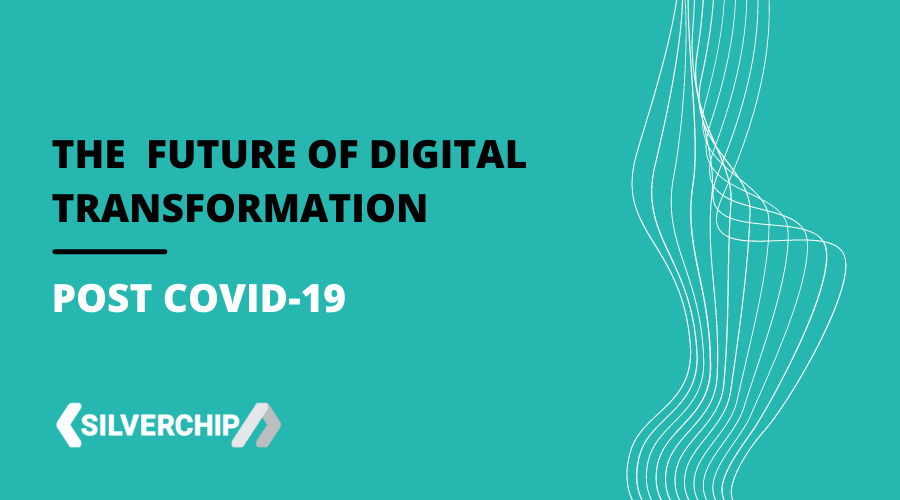
Pre-Covid-19, many organisations were on a journey towards a digital business model, each traveling at varying speeds. Many digital transformation efforts have been, until recent times, approached in an uncoordinated and fragmented manner, with different business areas failing to align objectives and work cohesively together.
The impact and scale of the pandemic has required a dramatic acceleration towards the investment required for digital technologies and infrastructure and the speed of the digital shift. The pandemic has resulted in management teams rushing to get behind and drive digital transformation strategies, they realise that digital is no longer a ‘nice to have’ initiative, rather a core business objective to continue serving and meeting the ever-evolving needs of their employees and customers.
We’ve listed five key priorities you should consider for your digital transformation strategy:
1. Covid-19 has changed digital transformation – for good.
Technology provides the opportunity for businesses around the world to engage and delight consumers and employees across the globe at any one time. Pre-Covid-19, organisations were only just beginning to realise the potential that tech capabilities offered their businesses. But, when work was limited and in-person meetings were cancelled, businesses quickly began to realise just how powerful technology can be.
The pandemic accelerated digital transformation and helped form a landscape that will continue to encourage tech innovation and enhancement moving forward. As organisations begin to better understand the capabilities of modern technology, organisations will in turn begin to realise and understand the opportunities that sit before them, even after the pandemic is over. It is likely that many of the digital shifts the pandemic has brought on are here to stay
As the pandemic forced brands to remove many of the barriers that once stood in their way of digital transformation, such as cyber security to enable employees to work remotely, it will be much easier for businesses to operate on a remote or hybrid basis. Many businesses have already made significant cyber security investment to assist them in protecting their digital security.
As well as cyber security investment, businesses have also begun to realise the power and potential of digital adoption such as innovation. Innovative technology that not only saves businesses money, but that also gives them an edge over competitors and helps them seize new opportunities. As these advantages are realised, businesses will be best placed to keep embracing and employing new technology and reaping in the benefits.
2. Greater focus and investment in cybersecurity.
As businesses continue to adopt and rely on technology and software, keeping data secure has become a critical priority.
According to IBM and Ponemon’s Cost of a Data Breach study, data breaches cost UK businesses an average of $3.88 million per breach and takes an average of 280 days to identify and contain, which leaves ample time for criminals to cause havoc and take advantage of exposed business systems.
Cybersecurity priorities within businesses have shifted moving away from routine support tasks and maintaining internal systems towards empowering remote employees. Those in charge of cybersecurity have quickly pivoted in their work and emphasis by utilising capabilities such as virtual private networks (VPN) and working on educating and protecting the remote workforce from scams and attacks.
Due to the large increase in remote working, many businesses have recognised the importance of increasing their cybersecurity spend. While this presents a problem for the industries that have been hardest hit by Covid-19, the importance of cybersecurity has become a critical priority for businesses across all industries.
3. Prioritise improving the customer and employee experience.
As many employees worked entirely at home for the duration of their local lockdown, businesses were forced to consider the impact on the employee experience using digital tools.
Pre-Covid-19, employees were grateful for any benefits that allowed for increased workplace flexibility. Now, however, with businesses adopting remote-first approach, the digital employee experience influences employee satisfaction scores with their work environment.
Whilst many businesses struggled with navigating the challenges the pandemic created, no business wants to deal with high turnover that can arise from low employee satisfaction and the costs involved with recruiting replacements. Businesses are now focusing on creating positive, productivity-improving digital experiences for employees and realising the immense benefits it has on the business.
Likewise, brands have also been required to focus on the ease with which their customers can interact and engage with them digitally. As most customers do interact with brands digitally, brands must minimise the issues that can arise from shopping and converting on their app or website.
4. More investment and prioritisation of technology.
Businesses across different industries have been forced to acknowledge that bringing new technology into their existing systems does not require perfection, rather, they have been able to adapt these technologies much faster than previously expected. According to research carried out by McKinsey & Co, respondents reported that their companies were able to adopt digital technologies 20 to 25 times faster than expected. With many of the respondents reporting that in the case of remote working, their companies moved 40 times more quickly than they thought possible pre-Covid-19. Before Covid-19, respondents stated that it would have taken more than a year to implement the level of remote working that was required during the pandemic. In fact, it took an average of just 11 days to implement a workable solution to enable employees to continue their jobs remotely.
This has likely been largely driven by businesses realising that systems did not have to work perfectly before being adopted. Simply having a digital solution that worked sufficiently allowed businesses to operate as normal whilst obeying national restrictions that forced people to stay home. Prior to the pandemic, more than half of businesses stated that a lack of prioritisation was the main reason why digital transformation was not adopted quicker. The pandemic forced businesses to prioritise and adopt digital transformation at lightning speed.
5. Adopting technology as a way to innovate and thrive.
Pre-pandemic, many businesses assumed technology was solely a way to reduce needless spending and save money. When in fact, when the data was analysed, teams using email automation as an example, saw that it saved time and also enabled customer service, sales and marketing teams to focus on other priorities. Digital transformation offers businesses incredible opportunities to innovate and get ahead in their industry.
According to research carried out by McKinsey & Co, pre-Covid-19, almost half of businesses reported that they viewed technology as a way to reduce costs as the main digital priority. However, as the pandemic brought further challenges, businesses began to realise that technology not only reduces costs, but that it also provides other solutions and benefits. By adopting new technologies, businesses can modernise their capabilities, gain competitive advantages and create a business culture that is focused on innovation.
If your company needs advice or assistance with digital transformation strategy or implementation, our expert team can help. We specialise in helping organisations understand and leverage the power of digital and technology to drive cost and time-saving efficiencies and innovation.
You can read more about our digital transformation success stories at https://bit.ly/34ZVnOm.









